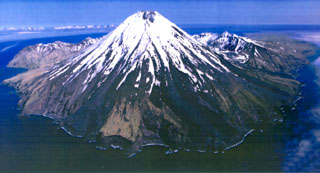Report on Kanaga (United States) — April 1995
Bulletin of the Global Volcanism Network, vol. 20, no. 4 (April 1995)
Managing Editor: Richard Wunderman.
Kanaga (United States) Occasional mild steam plumes
Please cite this report as:
Global Volcanism Program, 1995. Report on Kanaga (United States) (Wunderman, R., ed.). Bulletin of the Global Volcanism Network, 20:4. Smithsonian Institution. https://doi.org/10.5479/si.GVP.BGVN199504-311110
Kanaga
United States
51.923°N, 177.168°W; summit elev. 1307 m
All times are local (unless otherwise noted)
As of 31 March, observers in Adak (33 km E) continued to report occasional mild steam plumes above the summit. Through 31 March no thermal anomaly had been detected since 13 October 1994 when eruptive activity that began in December 1993 apparently ceased (BGVN 18:12 and 19:11). That eruption was characterized by intermittent, low-level steam and ash emissions producing plumes rarely rising over 3,000-4,500 m altitude and drifting a few tens of kilometers downwind. There are no seismometers on Kanaga, located 965 km WSW of the tip of the Alaska Peninsula on Kanaga Island, and monitoring is done through a combination of satellite image analysis and observations by pilots and residents of Adak.
Geological Summary. Symmetrical Kanaga stratovolcano is situated within the Kanaton caldera at the northern tip of Kanaga Island. The caldera rim forms a 760-m-high arcuate ridge south and east of Kanaga; a lake occupies part of the SE caldera floor. The volume of subaerial dacitic tuff is smaller than would typically be associated with caldera collapse, and deposits of a massive submarine debris avalanche associated with edifice collapse extend nearly 30 km to the NNW. Several fresh lava flows from historical or late prehistorical time descend the flanks of Kanaga, in some cases to the sea. Historical eruptions, most of which are poorly documented, have been recorded since 1763. Kanaga is also noted petrologically for ultramafic inclusions within an outcrop of alkaline basalt SW of the volcano. Fumarolic activity occurs in a circular, 200-m-wide, 60-m-deep summit crater and produces vapor plumes sometimes seen on clear days from Adak, 50 km to the east.
Information Contacts: Alaska Volcano Observatory (AVO), a cooperative program of a) U.S. Geological Survey, 4200 University Drive, Anchorage, AK 99508-4667, USA, b) Geophysical Institute, University of Alaska, PO Box 757320, Fairbanks, AK 99775-7320, USA, and c) Alaska Division of Geological & Geophysical Surveys, 794 University Ave., Suite 200, Fairbanks, AK 99709, USA.

